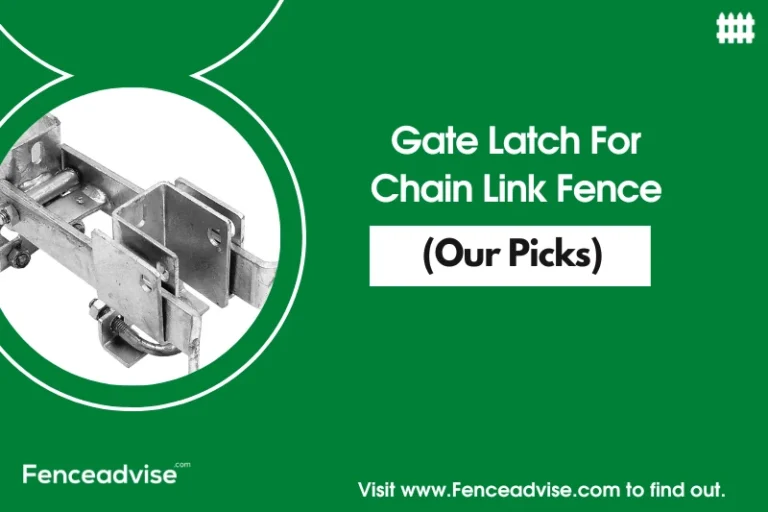We include products we think are useful for our readers. If you buy through links on this page, we may earn a small commission. Read our affiliate disclaimer here.
Installing a chain link fence without a top rail can provide many benefits. It can keep small animals and children from getting under the fence, and it can provide added security against intruders. Additionally, it can give your property a neater appearance and can be easier to install than a fence with a top rail.
Talk to a Fence Contractor Near You
How Can You Install Chain Link Fence Without Top Rail?
Installing a chain link fence without a top rail is a relatively easy task that can be completed in a few hours.
The most important thing to remember when installing a chain link fence without a top rail is to make sure that the posts are correctly installed and that the fence is level.
If the posts are not properly installed, the fence will not be level and will not look good.
Tools and materials needed:
- Tape measure
- String
- Pole or other support
- Shovel
- Post hole digger
- Tamping tool
- Cement
- Cement mixer (optional)
- Water
- Level
- String level
- Tension bar
- Tension band
- Wire cutter
- Wire stretcher
- Fence ties
- Gate (optional)
- Measure the area to be fenced, and mark the corners with stakes. Run a string between the stakes at the desired height of the fence.
- Drive a support post (pole, tree, etc.) into the ground at each corner. The support post should be tall enough that when the fence is installed, the top of the fence will be at the desired height.
- Use a shovel to dig post holes at each corner, and at intervals along the string. The depth of the holes will depend on the height of the fence. For a 4-foot (1.2 meters) high fence, the holes should be about 2 feet (60 cm) deep.
- Mix cement in a wheelbarrow or cement mixer, and fill the holes around the support posts. Tamp the cement down with a tamping tool.
- Add water to the cement, and mix it until it is the consistency of oatmeal.
- Fill the holes around the support posts with cement, and level them off with a trowel.
- Check that the posts are level using a string level, and adjust them if necessary
- Allow the cement to cure for 24 hours before continuing.
- Stretch a tension bar along the length of the fence, and attach it to the end posts with tension bands.
- Cut the chain link fabric to length with a wire cutter, and stretch it between the posts. Attach it to the tension bar with fence ties.
- Once the fabric is installed, the next step is to install the top rail. The top rail is attached to the posts with brackets. The brackets must be properly aligned so that the top rail is level.
- Install a gate (optional), and stretch the chain link fabric across it. Attach it to the posts with fence ties.
Get Matched with Local Fence Professionals
Answer a few questions and we’ll put you in touch with pros near you.
Does Chain Link Fence Need a Top Rail?
The answer is that it depends on the height of your fence. If your fence is 4 ft tall or less, then you probably don’t need a top rail. However, if your fence is taller than 4 ft, then you will most likely need to install a top rail.
This is because taller fences can be more susceptible to wind damage, and the top rail will help to prevent the fence from being damaged by the wind.
Also, if you live in an area where snow is common, a top rail can help to prevent the snow from accumulating on top of your fence and making it difficult to see.
But the top rail is not necessary for the stability of the fence. It is more for aesthetic reasons and to add rigidity to the fence so it is less likely to be damaged by the wind.
Advantages Of Chain Link Fence Without Top Rail
- A chain link fence without a top rail is convenient to install and remove.
- Used widely in gardens, residences, highways, railways, and airports.
- Easy to install and clean with a low cost.
- It has a long service life and it is not easy to get rust.
Find the right fence contractor for your project
Conclusion
Installing a chain link fence without a top rail is possible, but not recommended. Doing so would leave the fence vulnerable to damage and could potentially pose a safety hazard. When installing a chain link fence, it is important to use all recommended safety procedures and supplies to ensure a successful and lasting fence.
At FenceAdvise, we pride ourselves on being the most reliable and trustworthy source of fencing information. Our articles are based on only the highest quality sources, including peer-reviewed studies, to ensure that our readers always have access to accurate information. Read more about our Editorial Guidelines, About Us.









